The third-generation RAV4 is highly valued in the aftermarket.
At home, as well as in the US and Canada, the third-generation Toyota RAV4 crossover (XA30 series) debuted in 2005. It reached us and Europe a year later. In foreign markets it was offered with diesel engines and petrol V-shaped 3,5 litres "six". In Russian market it was officially available only with petrol atmospheric "four" of 2,0 litres (148-158 hp) and 2,4 litres (170 hp).
There was no three-door version of the RAV4. But there was a rather rare extended version, which appeared in 2008 and didn't undergo any major changes until production ended in 2014.
The standard version, on the other hand, underwent a subtle restyling in 2009. In 2010, not only the exterior has changed seriously: the two-litre engine has been replaced by a new generation unit (of the same volume), a variator has been added to the transmission range, and the five-speed manual gearbox has been replaced by a six-speed.
What hasn't changed is the high demand for the crossover on the secondary market - even now the price for ten-year-olds is up to 1.3 million roubles, and the owner of a pre-styled
Body
The paintwork is fragile. Chips are particularly quick to 'fade' on the edge of the bonnet. However, the metal is of sufficient quality - the body does not rust quickly. The most vulnerable spots are the bottom of doors and rear arches. The cars below the 2010 model year are often rusted near the chrome plating on bonnet. The coating on the light-alloy part of the wiper blades may swell and develop significant under-film corrosion.
The original windscreen is quite soft, easily rubbed and scratched. On pre-released cars, the seals on the lining under the glass may allow water to enter the passenger compartment.
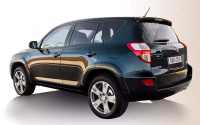
The side-opening tailgate, which accommodates the heavy spare wheel, is subject to wear on the hinge pins. Hinges are not cheap, 5-6 thousand rubles each, but they are bolted and easily replaceable. By the way, the versions for some other markets (including Japanese) have no spare wheel on the tailgate. Another cause of the fifth door knocking on the bumps can be eliminated by adjusting the lock.
The spare wheel cover's internal rubber stops will crumble and it will start to wobble. There's no need to buy a new one - just fit a universal seal.
Door-opening stoppers become loose after 5-8 years, and no longer fulfil their purpose.
Interior
The interior is full of hard plastic, which squeaks, and the number of crickets increases with time.
• The seat filler will sit out over time, the sides will buckle and lose their shape. The leatherette on the sides of the seats often cracks (especially in frost).
• The steering wheel with a rubberized rim and transmission selector lever are wearing out after 100-120 thousand kilometres.
• The locking mechanism of the upper glovebox often jams.
• The mountings on both parts of the armrest cover are not particularly strong and will come loose over time.
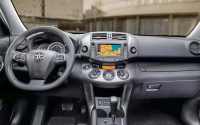
Electrics
On the whole, the electrics are quite simple and durable. But after 120-150 thousand km the alternator can break down because of the diode bridge.
The crossover was affected by the much-talked-about problem with the CTS electronic accelerator pedal, which has increased friction and became difficult to move because of wear. Pre-restyled cars older than 2010 have fallen under the service campaign to replace the unit. An indication that the pedal may be stuck in the partially depressed position is a difficult return.
Missing contact in the brake light switch under the brake pedal is a familiar sore from the first-generation RAV4.
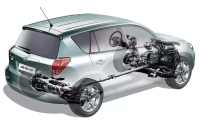
After 3-5 years, it's not uncommon for the heater motor to become noisy. It is not necessary to buy a new one (the average price is 4500 roubles) - as a rule, greasing of bearings is enough.
Engines
Engines 2.0 (1AZ-FE) and 2.4 (2AZ-FE) of the family, which appeared in 2000, are reliable. They differ in dia.
If the cylinder head fasteners are not tightened carefully, the threads in the aluminium cylinder block can easily be torn off. A loose fit leads to coolant leakage and overheating.
After 100-150 000 km, adjustment of valve clearances may be required (by selecting tappets). The water pump is prone to leak after 80-100 thousand km. After 100-120 thousand km leakage of crankshaft oil seals is common. After 120-150 000 km the timing chain drive and piston rings can wear out from bad lubrication.
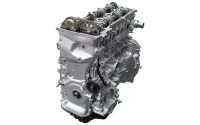
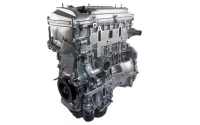
Throttle valve needs cleaning every 50-70 thousand km. Faulty idle speed valves and mass flow sensors lead to unstable idle speed.
The 2.0 (3ZR-FAE) engine, introduced after the 2010 restyling, does not require valve adjustment thanks to the presence of hydro-compensators, but is generally less reliable.
The cause of traction loss due to Valvematic valve lift mechanism is most often a faulty pressure sensor or system control unit. In both cases, the on-board diagnosis will report an error. You may try to avoid buying an expensive ECU (45k RUR) - the problem is usually a broken circuit, and the unit can be opened and re-soldered.
Failure of timing clutches on the intake and exhaust shafts Dual-VVTi (cost more than 12 thousand rubles each) can occur after 100-120 thousand km.
After 120-140 thousand km the vacuum pump often dies. Repairability of the node is low, and when buying a new one it is better to select the latest of its three modifications, advanced and more expensive - this will cost about 24 thousand rubles.
Transmissions
Five-speed manual transmission E325F series and six-speed EB61 (in restyling versions) are durable, have a resource up to 500 thousand km. They seldom cause troubles more than age seals leakage. Clutch is also durable and with moderate loads can serve up to 160-180 thousand km.
The four-speed automatic transmission Aisin U140F, developed in 2000, is not fast, but it is almost as reliable as a manual transmission. With the proper attitude and oil changes every 60-80 thousand km, it can run for at least 450 thousand km. It has high maintainability and can be rebuilt in the future.

Variator Aisin K11 in restyled 2.0 versions has half less service life compared to 4-speed automatic.
Variator is severely affected by dirty oil (replacement is recommended every 40-60 thousand km). Not only shaft and planetary support bearings can be subject to heavy wear - the flange on the housing of the differential suffers. The destruction of this thin-walled area is a death sentence for the unit, but in the case of small cracks, bushings and sealant can save the day.
If the mileage exceeds 250,000 km, a worn belt can cause serious consequences, as its links damage the internal parts of the gearbox.
Malfunctions of the variator after 120,000 km may be caused by any of the sensors or loose contacts in the connectors. Variator malfunction may also be caused by the ECU's central processing unit. Before buying a new unit it's possible to try and get it working again by resetting the software.
Transmission
The front-wheel drive versions have no transmission problems.
On 4×4 versions, the front angular gearbox is simple and durable.
Rear drive engagement clutch (65 thousand rubles) in prestyling crossovers is capable of failing in 60-80 thousand kilometres - the fault of the bearing with an unreliable seal. In upgraded crossovers it has increased size and has a service life up to 180-200 thousand km.
The oil in rear gearbox should be replaced every 30-40 thousand km. The oil seals of axles are inclined to leak in 80-100 thousand km. The shank oil seals should be replaced after 120-140 000 km. The PTO shaft has a service life of over 400 thousand km. However in case of wear of the crosses it can be replaced as a complete set - for 75 thousand rubles.
Suspension, Brakes, Steering
The first to fail in the suspension, after 50-60 km, are bushings front stabilizer bar, after 70-100 km - the strut.
Fogging of front shock-absorbers after 100 thou km is not a sign of their soon outage. It usually happens after 150,000 km.
Rear shock absorbers are more durable: they usually serve up to 200 thousand km. As well as the front ones, they also provide maximum service life, provided the dust covers are intact.
The tie rods of rear multilever suspension can wear out after 80-120 km. Instead of buying branded parts for 7-8 thousand rubles you can be limited to replacement of only silent-blocks - for non-original, only 350-400 rubles. But the most durable variant - tractions from restyled versions of the crossover, which have strengthened silent-blocks. Other silent-blocks both back, and front suspension McPherson, as a rule, endure 200 thousand kilometers.
The ball bearing on the front steel wishbone is replaced separately - usually not earlier than 160-180 thousand km. The hub bearings at 100-150 thousand km often have to be replaced with hubs for 7-12 thousand rubles.
In the steering mechanism with electric power in cars from 2007-2008 years of manufacture are weak plastic bushings at the output of the rack - often knocking after 50-60 thousand km. In the upgraded unit they serve up to 130-150 thousand km. Another frequent cause of knocking in steering is the linkages. But unlike the bushings, you can not change them separately, and a new steering rack assembly will cost 55 thousand rubles.
After 140-160 thousand km a steering shaft can be replaced (10 thousand rubles) with a broken cardan joint.
Brake calipers without regular cleaning and lubrication of guides are prone to jamming. Brake discs are easily warped by overheating.
Conclusion
With the exception of the most questionable two-litre version with variator, the third-generation Toyota RAV4 crossover, although not devoid of flaws, is more reliable than most of its classmates. This explains the slow drop in price and high liquidity.
Most recent

